Chapter 10 – More New Arrivals and Disaster
It seems that Richard McTaggart and his wife Emily (nee Harris) did not stay in Putty very long. Was it because Mrs. McTaggart found the roads a bit too rough? A newspaper report has it that while she and Mr. Oliver Cobcroft were out driving in a sulky it capsized by some means as they crossed a creek near the residence of Mr. Robert Ridge. Both were thrown out of the sulky and with the exception of a shaking and a fright escaped unhurt. Unhurt? They must have had at least a few scratches! Anyway, the horse freed himself from the sulky and galloped home with the harness flaying, leaving a badly broken sulky behind and its previous occupants to fend for themselves. (Singleton Argus 20th August, 1898)
Now living in Putty, George (Henry) Gibbs, married Catherine Harris, sister of William, Ma Harris’ husband. With this marriage came yet another melding of families. George and Catherine had five children, one was (William) George.
George was just eighteen years old when he enlisted to serve in the Great War. George returned home safely in 1919 and in 1934 married (Kate) Merle Orrell. Merle already had three children from a previous marriage so George built a family home at Long Swamp Putty which is still standing at the corner of Putty Valley Road and Bakers Road. It wasn’t long before their daughter Betty was born. I had the pleasure of meeting her at the centenary of Anzac held in the Putty Hall in 2015. A very proud and happy lady, she told me that she came close to dying as a baby saved only by her father’s ingenuity. He would soak a dry corn cob in milk and by sucking the milk from it, Betty survived. She also told me that as a child, she was never far from her father’s side, going everywhere she could with him. As she sat on a little wooden box nearby to where he was working, either alone or with other men, she learnt words a little girl should not. Consequently she got into a lot of trouble at school for saying the wrong thing.
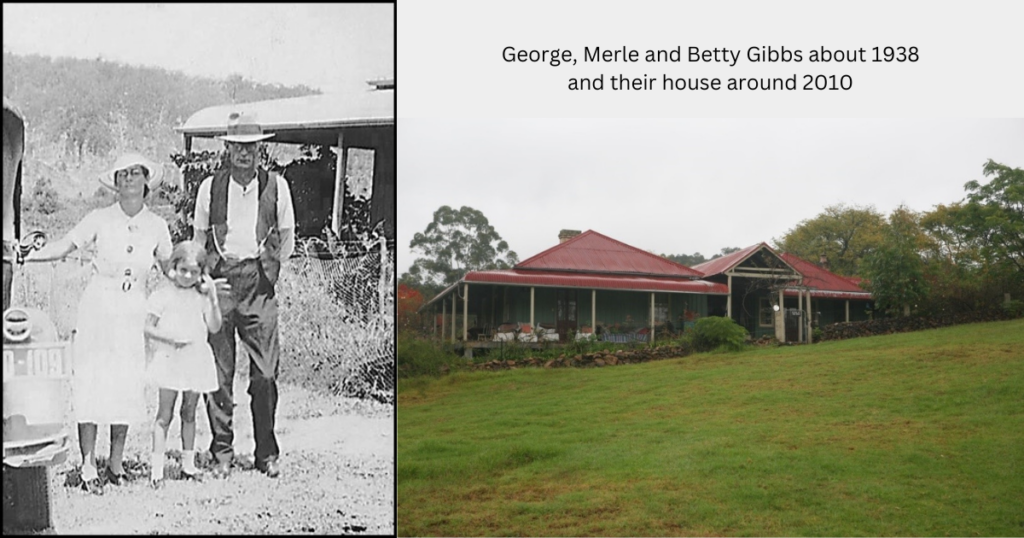
Chapter 11 – The Laycock Men ‘Removed From’** Putty
Andrew Laycock started his Hereford cattle herd in Putty in 1883 and by early 1908 had a fine herd, renowned for the young bulls which he regularly sold. Although he managed his cattle well, it seems he did not do as well with his finances. A Government Gazette notice dated 1896, indicated that the Sheriff was selling eight of his properties to satisfy a mortgagor debt of one thousand, seven hundred pounds ($3400) unless the debt was satisfied previously. The Bank of New South Wales also held bonds and securities given by him for the sum of three thousand, seven hundred and sixty three pounds, eight shillings and nine pence sterling. ($7528)
Andrew suffered his first stroke in April 1908 and a second one from which he died at his home in Putty on the 12th August the same year. Was it the stress of these debts and the loss his two four roomed cottages in the 1905 fire which caused the illness? After his death, his herd was sold very cheaply and did not find their way into any registered herd. In January 1910, the Bank of New South Wales served a Notice of Demand on Andrew Laycock, or if dead, to his representatives, for the amount due for the bonds and securities given him by the Bank. (extract Government Gazette 1910)
When Andrew died, funeral arrangements needed to be made so Mr. Jackson and Mr. Gibbs travelled to Singleton to do so and to purchase of a coffin with which they returned to Putty in readiness for the funeral. Using a horse and dray for transport, the trip took most of the day and stretched well into the night.
After Andrew had been laid to rest in the family cemetery at Putty, his widow, (Mary) Jane Thorley presented W.A. Jackson and G. Gibbs with a silver teapot each, in memory of the kindness shown by them to her late husband. They were each inscribed “Presented by Mrs. A. Laycock, in memory of her late husband, who died August 12th, 1908”.
The original 100 acres, Putty Farm, passed to the nephew of Andrew’s wife, Percy Crossing. In later years, it was owned by (Henry) Victor Turnbull whose wife Eudora was Percy’s sister. The property changed hands several times in the ensuing years and is currently owned by Steve and Therese Donnelly.
George Laycock and his brother Thomas also got into a spot of bother financially. From 1887 to 1890, they had each obtained four parcels of land in the Parish of Gullongulong at Putty under the terms of conditional purchase. In a Government Gazette notice dated Friday April 15th 1898, it stated that the Sheriff would cause to be sold by auction, these eight parcels, subject to all conditions remaining unfulfilled at the time of the writ. The Bank of New South Wales had called in its debts.
By 1908, all of George Laycock’s brothers had died and only his sister Emily and his niece May remained in Putty. With either employment or marriage taking his older children away from Putty and with his properties disposed of, George, with his wife Ada and their younger children, ‘removed from’ Putty to settle in Singleton.
** ‘Removed from’ was an expression used in the 19th century, since substituted by one word, ‘left’.
Their home “Chateau” in Kelso Street was referred to as the Concertina House possibly getting its name from its eight sided design. Ada died in 1916 and not long afterwards, George left Singleton to live with his daughter Alma, Mrs. R Aspey, in Arncliffe, Sydney. With no owner, the abandoned “Chateau” fell into disrepair. In 1934, following complaints from neighbours about “undesirables” moving in and causing problems, the house was demolished by Singleton Council.
George passed away in 1948 at Arncliffe, aged eighty nine years. His remains were transported to Whittingham Cemetery to be buried nearby those of his wife Ada.
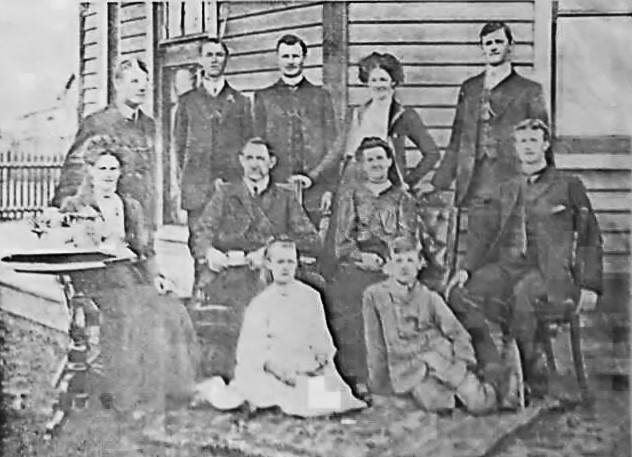
Top Row: Richard Walker (‘affianced’ to Lily), Cardinal, Kenneth, Lillith and Garnet.
Middle row: Lily, George & Ada (parents) and Stanley
Bottom row: Alma and Reginald
Chapter 12 – The Jackson’s Howes Valley and Putty
Thomas and Sarah Eather (nee McAlpin) were the first white settlers at Bulga arriving from Richmond in 1826. Thomas walked the distance leading bullocks with Sarah riding on one of them holding tightly to their baby son Thomas. That probably wasn’t so safe but she had no choice as she could not find a baby capsule for little Thomas which fitted onto a bullock.
Word got back to Richmond about the fertile land at Bulga and as the route between both passed through Putty and Howes Valley the pristine lands there did not go unnoticed.
Hannah and Samuel Laycock headed straight for Putty in 1824 onto the land promised to her in 1813 but members of the Merrick, Jackson and Medhurst families decided to give Howes Valley a try first.
I have already introduced you to Caroline, the daughter of Joseph and Maria Merrick who settled in Howes Valley and her first son, William Henry Merrick. It was he and his wife Catherine, who established themselves at Putty in 1888 and lived in those little slab huts still standing, lovingly restored, on Putty Valley Road. In 1860, Caroline married Henry Jackson from “Glendon”, on the Hunter River. They remained in Howes Valley and established a dairy farm where along with this pursuit they raised thirteen children. Several of their sons, including William Henry had quite an impact on Putty and Howes Valley.
While Henry Snr. was running the farm, Caroline was kept busy not only working by his side but also performing her role as the local midwife, soon earning the nick-name of Granny Jackson. She would travel on horseback day or night, along the tracks she got to know, to reach the imminent birth and was responsible for bringing a very large number of babies into the world at Putty, Howes Valley, Bulga, Martindale and Wollemi. Henry and Caroline continued to run their dairy farm until old age overtook them. They both died in the winter of 1933, ten days apart. Henry was ninety seven and Caroline was ninety two.
Another son of Caroline and Henry was Henry Jnr. born in 1863. Henry Jnr. bought Putty land, a two hundred acre parcel, which after Putty Hall was built, was located across Putty Creek behind the hall. Henry Jnr. established a horse racing track on this land which continued to be used for the sport and athletic events up until about 1950. Henry Jnr. married Agnes Ivory and they made their home at Howes Valley with their three children, Horace, Arnold and Ella. Horace and Arnold had the same sense of caring for others as did their grandmother. In 1918, during the Great War, they served as stretcher bearers at Peronne, France where they worked continuously for forty eight hours until utterly exhausted, saving the lives of the many wounded. Ella married George Cyril Medhurst, a son of Edward and Maria’s Medhurst.
The third son, William Albert Jackson was born in 1865. He was a carpenter, a builder of houses, bridges and any other thing which needed building. He was one of the first contractors on the old “Darkie Creek” Road, now the Putty Road.
William Albert arrived in Putty in about 1887 securing land in 1888, the same year as his brothers Henry Jackson and William Henry Merrick. He was responsible for the building of George Gibbs’ house at Long Swamp and his brother William’s house at “Hillview”. He rebuilt Henry Laycock’s old house, “Fairview” and if its similar design has anything to do with it, possibly built Wilfred and Eva Cobcroft’s home on Box Gap Road as well.
William Jackson married Amelia Wells at Darkey Creek in 189. They settled in Putty and in the ensuing years became the parents of seven daughters. William was particularly community minded and would devote himself to anything which brought advancement not only to Putty but also to Howes Valley and Bulga. He was the Secretary of the Howes Valley and Putty Cream Co-operative Society Limited for many years and when the society was forced into voluntary liquidation in 1913, he accepted the appointment of liquidator. By 1915, the telephone had come to Putty. William, along with several others, had major input into bringing this service to fruition. The amazing details of this achievement will be told later.
William, Amelia and their family spent twenty seven years in Putty. In July 1914, a number of Mr. Jackson’s friends from Bulga, Howes Valley and Putty assembled at his residence at Putty, to bid him farewell on the eve of his departure for Denman where he hoped to better himself. Speeches made were testimony to the high esteem in which Mr. Jackson was held by his friends and acquaintances. After supper was partaken of at 12 o’clock, a presentation was made by Mr. Frazer of Putty of a handsome tea service inscribed with “Presented to William Jackson by his many Putty friends”. (extract Singleton Argus 16th July, 1914) As was always occurred, dancing and singing were indulged in until the early hours of the morning.
Chapter 13 – Putty, a Popular Destination
John and Sarah Ann Medhurst (nee Diplock) were married in 1854 and settled in Howes Valley raising ten sons and two daughters. Their sons would often go hunting and on occasions with friends from Putty. Money could be made selling tanned animal skins at the markets or by claiming rewards offered by the Government for bringing in dingo scalps and crow heads. Each crow head brought a bonus of six pence. This bonus was offered when the Singleton Pastures Protection Board declared crows a pest after many farmers reported severe losses of sheep and lambs which had to be destroyed after crows had picked their eyes and brains out. (By 1936, ten shillings was being paid for a dingo scalp.)
A disastrous drought in about 1882 forced sons John, Walter, Laban and George to seek emergency grazing land for their stock. Searching to the north of Howes Valley, and travelling through extremely difficult country, they settled on land which was ‘beyond their expectations’ at Greig’s Creek, near Denman. This area is now known as Martindale. Settlers already in the area tried to dissuade the Medhurst men from moving in but they were not to be put off.
Having chosen their land, the men needed to go to Lands Department at Parramatta to register the selections. They found the New Windsor Road south, built by convicts, to be a tiresome journey even for such hardy men as themselves. However, the trip proved worthwhile as on arrival, they found that Governor Bourke had passed an act in 1825 that allowed a person of good character to squat on a parcel of land not already granted to someone else for the payment of ten pounds ($20) per annum. Their land at Greig’s Creek was secure.
After John Snr. died in 1905, Sarah with her younger children, moved from Howes Valley to Greig’s Creek to be with her sons who had settled there. Another son Edward, who was newly married to Maria (widow of Thomas Café), remained in Howes Valley with his family on their “Bungarraby” property.
It was time for the remaining Medhurst sons to set up home. It was only a two day ride by horseback from Martindale to Howes Valley or to Putty, so Jonathan with his wife Eliza (Café) and Joshua with his wife Ada Clara Martha (Merrick), (step-sister of George Henry Gibbs), took up their selections at Putty.
Putty had become a very popular place. Land for selection, conditional lease, conditional purchase, or annual lease was being highly sought after. During 1905 and 1906, over 18,000 acres had been officially allocated to more than twenty settlers bearing the names Chapman, Cobcroft, Gibbs, Gosper, Hall, Knodler, McTaggart, Medhurst, Merrick, Ridge, Smith and Sylvester, their names, settlement dates and land size recorded on at least seven of the local parish maps.
John Café, son of Maria, ventured south to Putty in 1907 and married Oliver and Emily Cobcroft’s daughter Mary. Their son Geoffrey Ernest was born in 1908.
John was the driver of the Howes Valley-Putty cream van which he would take regularly from Putty to Singleton and return. There was a cream depot at the Cobcroft’s Condon Clear property; the furthest most pick up point on the cream route. On reaching Mt. Thorley during one of his deliveries, the horses pulling the van were startled by men working on the road and took off at a run. They broke away from their harnesses and the van toppled over an embankment. It was only slightly damaged but the contents of twenty five cream cans were lost. John was thrown a considerable distance and amazingly only got a few bruises. Fortunately the horses were caught, reharnessed and the journey continued. (extract Singleton Argus-Tuesday 28 November 1911)
In 1919, Oliver and Mary Cobcroft’s son Wilfred married Eva Medhurst., (step-sister of John Café) and built a home for her on Box Gap Road Putty. Although showing its age now, the building still exists. Wilfred and Eva had no children of their own but raised Geoffrey Café from about the age of fourteen years after both his parents had died in their early forties, John in 1918 and Mary in 1922. Geoffrey married Pearl Bates and with children Ronald, Enid and Maureen also lived on Box Gap Road.
Settlement in Putty was now wide-spread, a vast difference from its beginning described by Robert Ridge, as “a howling wilderness, inhabited mostly by aborigines”. By 1920 is had become a thriving village with about one hundred and fifty residents spread from one end of the valley to the other.
Chapter 14 – The Turnbull Family
It appears that Harper Augustus Turnbull did not live on the Putty properties he bought in 1888, preferring the Hawkesbury district as his home. In about 1890, his father, Henry War Turnbull with his wife Margaret and their children, left the old family home at Colo and moved to Putty to live on Harper’s land. Henry and his wife were the parents to five daughters and nine sons, one son being (Henry) Victor, born in 1880.
In about 1910, Vic with his wife Eudora, (nee Crossing), established a home and farm beside what became known as Turnbull Creek, a small creek running parallel to Putty Creek on its eastern side. It was from there that Vic operated the Putty Post Office after it was officially reopened in 1927.
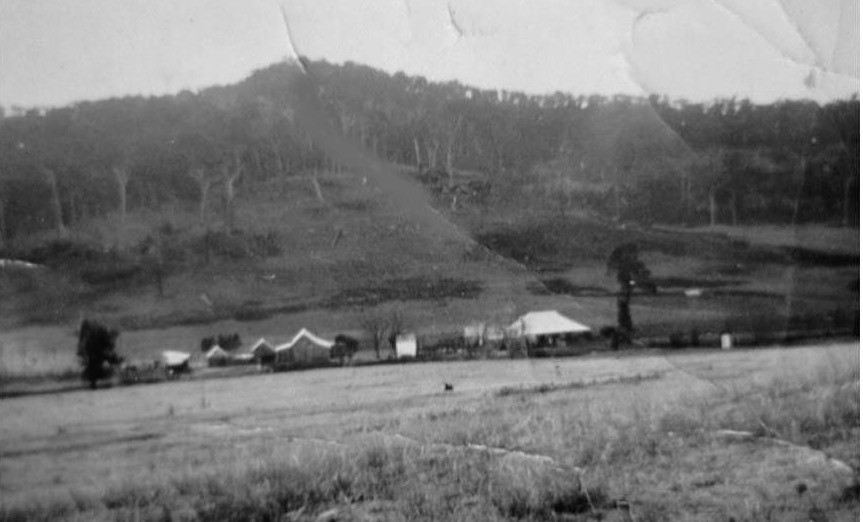
Their home could be seen towards the North-East of Putty and included the Post Office. The homestead was extensive with a dairy, sheds, yards, a calf paddock, a bull paddock, an orchard, a pig run and a cave for a pig called “Old One Ear”.
Vic had access to “Big Lagoon” which he emptied by digging drains to direct the water into the natural channels of Putty Creek. Using a horse and scoop, shovels and some unwilling workers, the project took several years. With the fertile ground exposed, the base of the lagoon became ideal for growing good crops of corn for many years. It also meant that in wet times the corn field became a flood plain.
The Turnbull family had left Putty before my family and I arrived. Not much was left of the buildings and only a few pieces of machinery were lying about. It was still easy to see where buildings and yards had been and remaining in place was the pig run, an enclosure made from upright ironbark posts sunk into the ground very close together. In the remains of the orchard were plum and persimmons trees, struggling to bear fruit. Sadly with the passing of time and different owners having their own dreams of how a property should look, nothing but soil and grass is left now. Even the lagoon, painstakingly drained by Vic for crop growing, is full of water again.
Vic and Eudora became the parents of three daughters and five sons. One in particular, (Garnet) Lloyd, born in 1913, formed a very close bond with Putty which remained with him until the day he died. His life was the land. He went to school at Putty, liked Mr. Paul his teacher but did not like school very much.
Lloyd and his brother Ray did not wear shoes and not too many of the other boys in Putty did either. When the cold of winter came they would run through the paddocks to school to keep warm and when finding a fresh cow pat, even one covered in frost, they would break the frost and stand in the pat to warm their feet.
As Ray and Lloyd got older and more children were born, their house became so crowded that the two boys were moved out to the side verandah to sleep. One winter, their sister Edna realised how cold they were so she sewed hessian sacks together and filled the finished product with cornhusks. The boys now slept warm under the cover of their corn husk doonas which were probably a little scratchier and noisier than the ones of today but just as welcome on cold Putty nights.
I met Lloyd, his brother Ben and their wives Hannah and Ruth several times at the Putty Hall dances which they often attended up until about 1990. Lloyd never lost his love for Putty and made many trips back to the home of his boyhood for a look around.
Chapter 15 – Social Events
A Trip to Putty
At the invitation of Mr. and Mrs. R. Ridge, a party of ladies and gentlemen accompanied by R. Hennesay of Comleroy Road journeyed to Putty to a picnic and dance held on Friday the 22nd inst. (of May). About fifty couples sat down to a sumptuous repast provided by the hostess and others. After lunch, games and sports were indulged in then dancing commenced at 7 p.m. and was kept up with great vigour until the small hours of the morning. The music was first-class being supplied by Mr. A. Bowman assisted by Mr. M.J. Butler. After spending a most enjoyable time, the party dispersed for their homes. Too much praise cannot be accorded to Mr. and Mrs. Ridge for this kind way in which they treated their Comleroy visitors who stayed a few days admiring the beauties of Putty thence returning home on Tuesday after a very pleasant trip. (extract Singleton Argus 3rd June, 1896)
An Easter Celebration
A ball and supper was held at the residence of Mr W.A.Jackson on Easter Monday night and the function was a great success. About 40 couples danced to music provided by Mrs. Victor Turnbull, Miss Minnie Turnbull, Messrs J. Dodds, L. Café and H.S & A. Turnbull. The M.C. was Mr. Victor Turnbull. Supper was served at midnight and full justice was done to the tempting foods which included poultry, sucking pigs and sweets of all kinds. Dancing was continued until 5 o’clock on Tuesday morning. During intervals, songs were rendered by Misses J. and M. Turnbull and the vocal numbers were much appreciated. Thanks are due to Mr. W. A.Jackson who so kindly provided the floor for dancing.
The dresses worn by the ladies were a credit to the district. Those worthy of special mention were: Miss Doris Merrick, kingfisher blue satin and cherry trimming; Miss Phyllis Merrick, pink satin charmante; Miss A. Chapman, hand-embroidered tulle; Miss Valda Merrick, buttercup satin and king fisher blue trimming; Miss V. Harris, green satin; Miss M. Chapman, blue georgette over maize; Miss M. Merrick, shot taffeta; Miss L. Harris, navy silk.(Extract Singleton Argus13 April 1912.)
The ladies wore dainty little strappy high heeled shoes and carried a little purse to compliment their frocks. The men wore dress trousers, jackets and a tie and their shoes were a soft soled dancing pump made for gliding gracefully with their dancing partner. For the extra touch, “Pops” or sawdust laced with kerosene was sprinkled liberally on the timber dance floor to make it even more user-friendly.
Dancing and feasting until the wee small hours of the morning seemed a regular occurrence. People arrived at functions either on foot or by their horse and cart, in daylight hours. Finding the track back home on a moonlit night was no problem but on one of those deep dark nights in Putty when you cannot see your hand in front of your face, neither could the tracks be seen. Hence, revellers stayed until daybreak and I don’t wonder why. I know firsthand that walking around the Putty bush on a very dark night is scary. There is definitely “things” out there!
Cricket matches
Cricket was a favourite pastime and games held were mainly between the Putty and Howes Valley Cricket Clubs although a team from Bulga would on occasion join in. So important were they that the results of the games and the names and achievements of the players were reported, always in great detail in the next edition of the Singleton Argus. Of course a picnic lunch followed each event with a “sumptuous repast provided by the ladies.”
However, things did not always go well for the cricket club as at one stage, in early 1906, a meeting was held at Mr Turnbull’s residence where “it was unanimously decided to sell the cricket material on hand, disband the club and after paying a small debt, that the balance be handed to the Singleton Hospital.” (extract Singleton Argus 24th February, 1906). Perhaps the disastrous fire of 1905 coupled with the deaths of William Harris, Andrew Laycock and Robert Ridge around this time, affected people so much that cricket was no longer a game to be enjoyed.
In later years, cricket had resurgence in Putty. A concrete pitch was constructed nearby the Putty hall and games continued well into the 1960’s. In the late 1940’s when my husband Kendall was just a young boy, his parents would bring him and his grandmother Stella (nee Greentree) to Putty where they would lean over the fence to watch the games. He never questioned why, you don’t as a child, but as history has unfolded it revealed that his ancestor Reuben Greentree married Ann Farlow, May Elizabeth Harris’ great Aunt. So watching the cricket and catching up with her rellies would have made it a nice outing for his Nana.
Chapter 16 – Putty Hall, Picnic Races, WW1 and Sue Harris
The social life in Putty during its early years was quite diverse not only involving cricket matches and dances but also horse racing, athletic carnivals, card games and ping pong. People from Putty, Howes Valley and further afield gathered together for these events which were, along with many parties for special occasions held in private homes. There was always a meal to be shared after which furniture would be rearranged to allow space for the lovers of Terpsichore, the art of dancing, to trip the light fantastic.
William Jackson, Arthur Barwick, Vic Turnbull and Ma Harris regularly provided their homes for various types of functions as did Andrew Laycock prior to his death and Robert Ridge before he left Putty. As the population of Putty Increased, so did the need for somewhere larger than the dining and lounge rooms of a family home, somewhere suitable to accommodate all the guests at the functions. This led to the idea of building a public hall.
New to Putty was (Daniel) Steve Ellis. Steve originally came from Gloucester but after venturing south to Kurrajong he, along with other drovers often moved cattle from there to areas north. He described the road from Kurrajong to Putty as more often than not, an indistinct track through the timber and bush grasses. He had arranged to visit Putty with his draught horse stallion to service mares and decided to stay. He purchased the property that was once Henry Laycock’s and named his home “Fairview”.
Steve Ellis, Wilfred Cobcroft and George Gibbs were the principal movers in securing land on which to build the hall. Subsequently, the land for the hall was donated by Steve after having been allocated by ballot to him from land offered by Mr. A. E. Merrick. This land may have been land acquired previously by a mortgagor via default of mortgage conditions. Construction of the hall began sometime prior to 1913 as it was in that year when George Gibbs, William Frazer and Wilfred Cobcroft were appointed trustees of the land on which a hall existed. Timber stumps were used for the foundations and adzed poles were sunk into the ground in readiness for the walls. On examination it is possible that the dance floor was in place before the walls and roof were built. It was built as a multi-purpose hall, described on the transfer document as, “for the use of the residents of Putty for public, religious and social gatherings and for such other purposes as the said residents may from time to time determine”. The Putty hall was officially opened on 17th October, 1918. When built, it was a substantial structure of hardwood, measuring 40ft by 20ft expected to be of service for many years to come.
Across Putty Creek, just behind the hall, was the race track on land which Steve Ellis had bought from Henry Jackson Jnr. Regular gala events and annual picThe social life in Putty during its early years was quite diverse not only involving cricket matches and dances but also horse racing, athletic carnivals, card games and ping pong. People from Putty, Howes Valley and further afield gathered together for these events which were, along with many parties for special occasions held in private homes. There was always a meal to be shared after which furniture would be rearranged to allow space for the lovers of Terpsichore, the art of dancing, to trip the light fantastic.
William Jackson, Arthur Barwick, Vic Turnbull and Ma Harris regularly provided their homes for various types of functions as did Andrew Laycock prior to his death and Robert Ridge before he left Putty. As the population of Putty Increased, so did the need for somewhere larger than the dining and lounge rooms of a family home, somewhere suitable to accommodate all the guests at the functions. This led to the idea of building a public hall.
New to Putty was (Daniel) Steve Ellis. Steve originally came from Gloucester but after venturing south to Kurrajong he, along with other drovers often moved cattle from there to areas north. He described the road from Kurrajong to Putty as more often than not, nic races were held there. Many outside entries were invited and some came from as far away as Fordwich and Maitland. Dances, of course with “sumptuous” suppers, usually followed the racing events and proceeds from both were spent on social and religious needs and hall improvements. On other occasions, special events were held so that money could be donated to the Putty Anglican Church or Putty school as well as Dangar Hospital in Singleton where many a person from Putty received care.
1914 and the First World War was declared. This saw an upheaval in the lives of all Australians including those living in the small village of Putty. Five young Putty men enlisted to serve. They were Clarrie Cross, George Gibbs, Carrington Laycock, Jack (Jonas) Medhurst and Roland Merrick. Clarrie served in Alexandria and France, George in Suez, Port Said, Egypt, Ismailia and Moascan and Jack was a ‘tunneller’ in France, Omer and Boulogne. Carrington and Roland did not embark for overseas service. Thankfully all the Putty men returned home safely.
Ma Harris continued to live in Putty with her girls. Not long after Steve Ellis arrived in Putty, he and one of Ma’s daughters Sue (Rachael Susannah) were married. They set up home at “Fairview” in 1923 and their four children, Owen, James, Vera and Fay were born. Over time, Steve purchased a number of other properties throughout Putty, including those originally owned by members of the Laycock family.
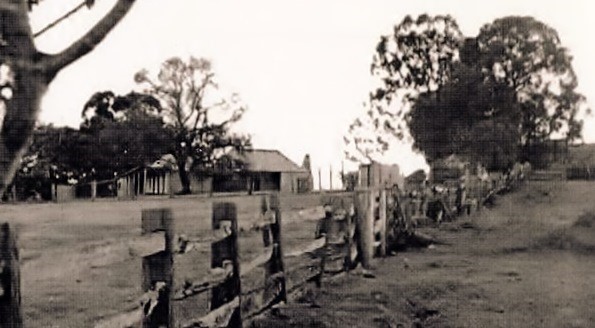
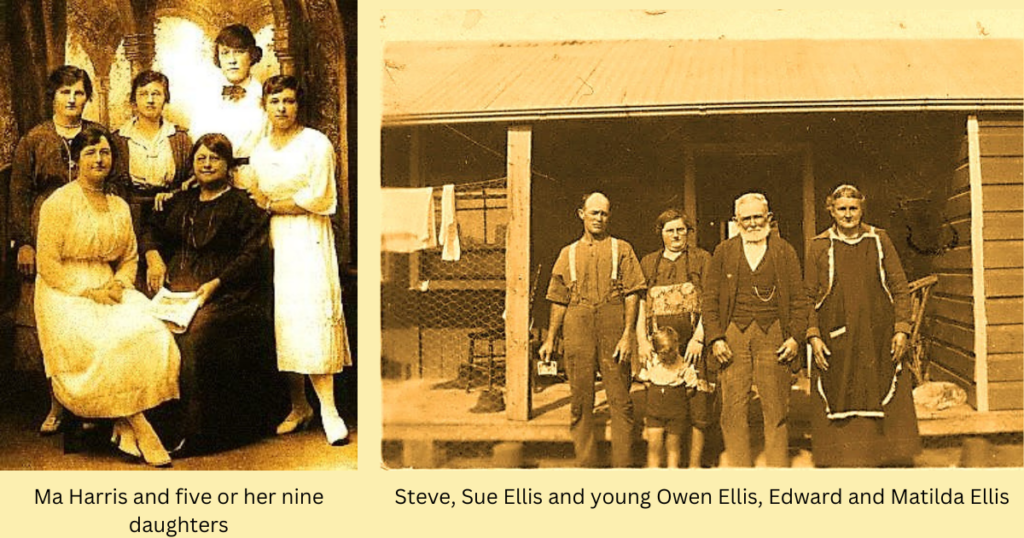
Chapter 17 – Telephonic Communication, Bulga to Putty
In 1911, A PETITION was prepared to present to the Postal and Telegraph Department to establish telephonic communication from Bulga to Howes Valley and thence to Putty. Signatures were sourced from Singleton, Broke, Wollombi, Howes Valley and Putty. The petition pointed out that Putty was 40 miles (64 Kilometres) from Bulga which was the nearest telephone office and 60 miles (96 Kilometres) from Windsor where the Land Board business, as far as Putty was concerned was carried out. All other business, including banking, was carried out in Singleton and it was only considered right that Howes Valley and Putty be connected with this centre. Mr. W. Merrick had the matter in hand and hoped for a successful conclusion.(Extract Singleton Argus 2nd September, 1911)
On the 29th June, 1914, a proposal was received from the Postmaster General’s Department. It included the number of poles required and the amount of wire necessary. The very detailed estimated cost of the line was 765 pounds ($1530.00). The residents were required to contribute approximately one third of this amount or as an alternative, they could supply and erect the poles themselves under supervision, in which case the Department would pay them to do the work. The telephone line from Bulga to Putty would need a total of 761 poles, ranging in length from 20 to 25 feet (6 to 7.5 metres). The Department would supply the 40 miles plus 25 chains (total of 65 Kilometres) of wire and insulators etc., to be fixed on poles and trees. The lines would need to be maintained by the residents upon payment to them of 5 per cent of the cost of construction. (extracted from Singleton Argus, Thursday 9 July 1914)
A TELEPHONE LINE HAS BEEN COMPLETED IN HOWE’S VALLEY, 34 miles (55 km) from Singleton and it is proposed to link the connection as far as Putty. The telephone will be a great boon in these settlements. The first message from Howe’s Valley was received on Monday by a local firm of auctioneers, who were advised that three stockowners at Putty were sending in consignments for Wednesday’s stock sales. The auctioneer thus had ample time to make arrangements for the disposal of the cattle. (The Maitland Daily Mercury 12 November, 1915)
It was not even a year and a half after the proposal was received that Howes Valley residents had a telephone in their home and the Putty residents, just one month later. What an amazing feat especially considering the equipment they had at their disposal. With no cherry picker or crane in sight, horses, ropes and pulleys would have been used to erect the poles and ladders to reach their tops to fix wires. (And for the curious, cherry pickers were invented by Mr. Jay Eitel, an American, in 1944 initially for just that reason.)
Friday 10th inst. (December 1915)was A RED LETTER DAY IN THE HISTORY OF THE PUTTEYITES. The advent of the opening of the telephone extension to Putty was celebrated by a social evening at Green Hills, the residence of Mrs. M.E. Harris to which invitations were extended far and wide. The assemblage included visitors from Broke, Bulga, Howe’s Valley and surrounding districts. The organisation of the function was in the capable hands of Mr. R.D Merrick and included dancing and supper set up in a marquee decorated in luxurious fashion. A number of speeches were made befitting the occasion and special mention for bringing the proposal to a successful conclusion was made to Mr. Joel Atkin of Singleton and Mr. W. Jackson (since moved to Denman) who may be termed the fathers of the movement. With determined effort, the residents placed all the poles required on the line and erected 118. The balance of the work was carried out by the Postal Department under the supervision of Mr. Croese and his gang of men. (Extract Singleton Argus Thursday 16th December, 1915)
A Celebration at Howes Valley
Although the Howes Valley-Putty telephone line has been open for business for some time nothing had been done to celebrate the opening up till recently. The celebrations took the form of a social evening and banquet attended by over sixty people from Bulga, Howes Valley and Putty and was held at the Howes Valley Hall on Friday 28th ult, February 1916 and was an unprecedented success.
Mr. Fleming, M.H.R. paid glowing tributes to Mr. W. H. Merrick and Mr. W. Jackson, the primary movers for the phone and to Mr. Joel Atkin, Messrs W. MacTaggart Sen. W. Halton and B.G. Harris Sen. and the contractor, Mr. Joe Merrick.
About 6 a.m. the company dispersed, satisfied they had done much good in assisting in the establishment of the phone which brings their district commercially and socially within closer reach of the outside world. (extract Singleton Argus February 8 1916)
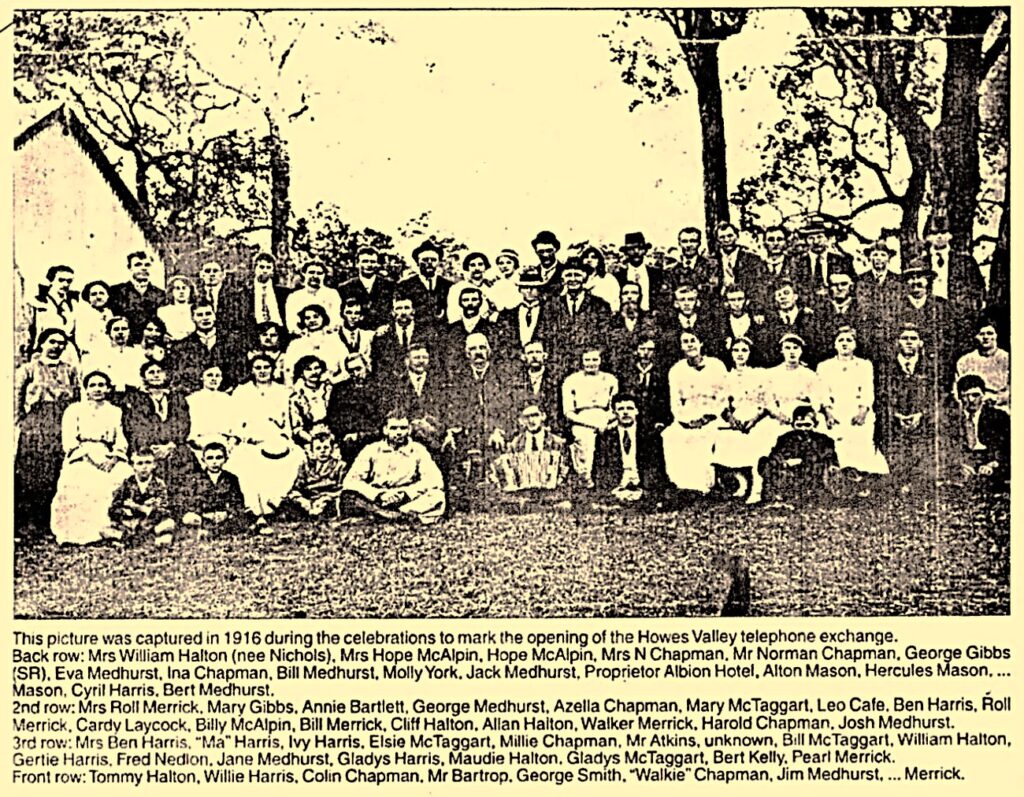
I am a descendant of John Taggart so found this information very interesting John fathered 8 children, 3 boys and 5 girls to Emily or multiple Aboriginal women but we do not know any information bar Emily
Maybe you have some further information?
Many Thanks
I have just been reading your website, I found it so interesting, I spent quite a lot of times with Eva & Wilfred Cobcroft at Putty when I was young. Eva was my Grandfather’s step-sister to Leo Cafe from Singleton.
My Grandmother was Sophia Jane Taggart /Cafe from Howe’s Valley, who married Leo Cafe, 30-6-1909 at Howe’s Valley.
Regards Des Cafe.